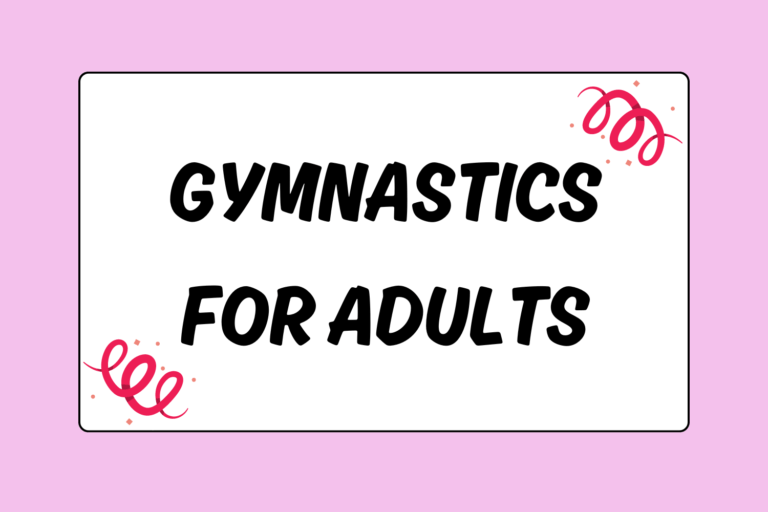There are five distinct sports under the umbrella of gymnastics: artistic gymnastics (men’s and women’s), rhythmic gymnastics, aerobic gymnastics, acrobatic gymnastics, and trampoline. There are specific requirements for the gym and equipment used in each sport implemented by FIG, the governing institution of gymnastics.
The regulations and specific dimensions below are taken from the 2009 FIG Apparatus Norms for Gymnastics.
Artistic Gymnastics
In artistic gymnastics, men and women compete on different apparatuses. The men compete in six events: floor, pommel horse, rings, vault, parallel bars and horizontal bar. The women compete in four: vault, uneven bars, balance beam and floor.
Each apparatus has its own set of rules and its own dimension requirements.
Floor Exercise
The dimensions for the floor are the same for both men and women. The floor is a 12 x 12 meter square mat with a horizontal surface, slightly elevated from the ground at a maximum of 3.5 centimeters. The border around the mat may not have a slope exceeding 25 percent.
There is also a 2m zone around the performance area that must remain clear without obstructions.
Vault
The dimensions of the vaulting table differ slightly between men and women. The table is set at 125cm high for women and 135cm high for men. For both men and women the table is 120cm long and 95cm wide. The top of the table must be completely cushioned with a surface that is not slippery or rough. The surface of the push-away area (the top of the table) must absorb shock so that the shoulders and wrists are protected.
The runway for the vaulting table may not exceed 25m in length. It is 100cm wide and no more than 2.5cm high. The start of the runway must be marked so the gymnast knows where to initiate her run.
At the end of the runway there is a vaulting board that helps propel the gymnasts onto the vault. The board is 120cm long, 60cm wide and 20cm high. The landing mat behind the vault is 6m long and 2.5m wide.
Balance Beam
The balance beam is 10cm wide, 5m long and 1.2m off the ground. The entire beam must be padded with rounded edges at the end. The cushioning must be between 15mm and 30mm thick.
The landing mat at both ends of the beam is 17 x 4 meters.
Uneven Parallel Bars
The uneven bars are performed on a set of two flexible bars that are a maximum of 1.435m apart from each other. The upper bar is 2.5m above the floor and the lower bar is 1.7m above the floor. The landing mat is 14m long and 2m wide.
Still Rings
This apparatus consists of two rings, circular in shape, that are suspended from the ceiling and parallel to each other. The rings hang 2.8m above the floor from a 70cm suspension strap. The two rings are 50cm apart and each have an inner diameter of 18cm.
The landing mat is 5 x 2m.
Parallel Bars
This event is performed on two flexible bars that are set 2m above the ground. The bars stand parallel and between 42 and 52cm apart from one another.
The landing mat is 11m long and 4.5m wide.
Horizontal Bar
The high bar is a single bar set 2.8m above the floor. The bar is 2.8cm in diameter and 240cm in length.
The landing mat underneath the bar is 12x12m.
Pommel Horse
The pommel horse is a semi-oval shaped apparatus with two handles (pommels) on the top. The edges and corners of the horse are all rounded, giving it a circular profile.
The top of the horse is 160cm long and 35cm wide. The bottom of the horse is 155cm long and 30cm wide. When measured from the floor, the horse is 115cm high.
The pommels are 12cm high from the top of the horse and are placed 40 to 45cm apart from one another.
The landing mat underneath the horse is 4 meters long by 4 meters wide.
Rhythmic Gymnastics
Rhythmic gymnasts use five different tools in their routine: the rope, the hoop, the ball, the club and the ribbon. The routines are performed on a 13 x 13m mat with a 50cm border. The gym ceiling needs to be at least 8m high—but 10 to 12m is recommended. There is also a required 2m safety zone around the floor.
Rhythmic Rope
The length of the rope is in proportion to the height of the gymnast. The rope can have an anti-slip material, which may not cover more than 10cm.
Rhythmic Hoop
The hoop must have an interior diameter of 80 to 90cm and weigh a minimum of 300 grams. For children, the hoop’s diameter is determined by the size of the gymnast and must weigh 225 grams.
Rhythmic Ball
Ball requirements are dependent on age and level of the gymnast. Children must use a ball with a diameter between 14 and 20cm; all other levels use one with a diameter of 18-20cm.
The weight of the ball also differs based on the level of the gymnast. A level 9/10 gymnast must use a ball that weighs a minimum of 400 grams and a level 5-8 gymnast must use one that weighs at least 330 grams. Lower level gymnasts can use a lighter ball with a minimum weight of 200 grams.
Rhythmic Clubs
A gymnast will use two clubs per routine. The club, a bottle-shaped tool, must be between 40 to 50cm in length and must weigh at least 150 grams. The top of the club has a maximum diameter of 3cm.
Rhythmic Ribbons
The ribbon is broken into two parts: the stick that attaches to the ribbon and the ribbon itself.
The stick is 50-60cm long and has a maximum diameter of 1cm. The attachment used to connect the ribbon to the stick cannot be longer than 7cm.
The ribbon must be at least 6m long (5 meters for junior age and 4.5 meters for children) and 4-6 cm wide. It must weigh (without the stick) a minimum of 35 grams (30 grams for junior age and 20 grams for children).
Aerobic Gymnastics
Aerobic gymnastics is performed on a 7 x 7m floor with a one meter safety zone around the outside. For group performances, the floor is must be 1000 x 1000cm.
Acrobatic Gymnastics
Acrobatic gymnastics is performed on a 12 x 12m floor with a 2 meter safety zone around the outside.
Trampoline
The bed of the trampoline must be at least 422cm long and 209cm wide. The jumping zone on the mat is 215cm long and 214cm wide with a center marked by a 70cm red cross. The frame and the springs of the trampoline must be entirely covered with padding that is between 2.5 and 5.5cm thick. The padding may go over the mat, but by no more than 3cm, and it must not detract from the required size of the bed.
General Requirements
The gym ceiling needs to be a minimum of 8m high, but 10 to 12m is preferable.
There must be safety platforms, otherwise known as end decks, at the end of the trampoline. They have to be 240cm long, 300cm wide, 7.5cm thick on the sides of the bed, and 20cm thick at the ends. The foam of the mat on the end deck needs to have a density of 25kg/m3.
For synchronized trampoline two meters must separate the trampolines from each other.
Spotters and Spotter Mats
Spotter mats must be 200cm long, 150cm wide and 15cm thick with either two handles or one handle on the length side. Additional mats are required for the floor around and in between the trampolines. They need to be 20cm long and 200cm wide. Two 5 x 10 foot x 8 inch mats are required at the end of the safety platforms.
One capable spotter (of appropriate size for the competitor) is required on each corner of the trampoline.
Overlap
Even though there is some overlap in regards to equipment used in the five sports, each has its own distinct set of dimensions. FIG has designed these dimensions to ensure the safety of all gymnasts who participate in the sport.





